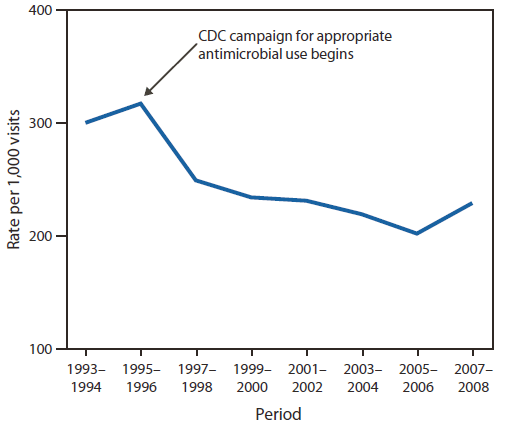Average annual antibiotic prescribing rates for children under 14 years of age dropped from 300 per 1,000 physician office visits to 229, a 24% fall, during the periods 1993-1994 to 2007-2008, a Morbidity and Mortality Weekly Report (MMWR) revealed today. MMWRs are issued by the CDC (Centers for Disease Control and Prevention).
Eight years ago the IOM (Institute of Medicine) warned that antibiotic resistance had become a major microbial threat to health in America – a threat at individual and country level. The IOM urged doctors to use antibiotics appropriately, as part of a strategy to combat this threat.
The authors of the report gathered data on antibiotic prescribing rates – some of the reductions or lack of reductions appear below:
- Pharyngitis – 26%
- The common cold (nonspecific upper respiratory infection) – 19%
- Otitis media, sinusitis and bronchitis – no significant change
The authors of the report stressed that current rates are still high, despite the fall over the last decade.
Average annual antibiotic prescribing rates for persons aged ≤14 years per 1,000 physician office visits — National Ambulatory Medical Care Survey, United States, 1993-1994 to 2007-2008

The authors explain that even though these figures are encouraging, several areas require further improvement. 58% of antibiotics prescribed at doctor’s offices in 2007-2008 were for five acute respiratory infections – the majority of which require no antibiotic medications. Unfortunately, patients expect to be treated with antibiotics and doctors appear to be influenced by this, leading to inappropriate antibiotic usage.
Even though the American Academy of Pediatrics released guidelines in 2004 recommending watchful waiting for healthy children under the age of two years with otitis media and no severe symptoms, antibiotic prescribing for this indication has not dropped significantly over the last ten years.
The drop in antibiotic prescribing for pharyngitis from 1993-1994 to 2007-2008 was mainly due to rapid diagnostic testing for group A streptococcus, which improved decision-making with regards to what treatments to use.
Common pathogens are acquiring progressively increased resistance to antibiotics, resulting in an ever dwindling choice of treatment options. Reducing inappropriate antibiotics usage is vital for public health in the USA, the authors stress.
In Europe, the problem is very similar. Young children are the principal users of antibiotics and most of them are prescribed for upper respiratory infections. According to German health authorities, one third of all Germans have taken antibiotics over the last 12 months – and Germany has the third lowest usage of antibiotics in the European Union.
Written by Christian Nordqvist